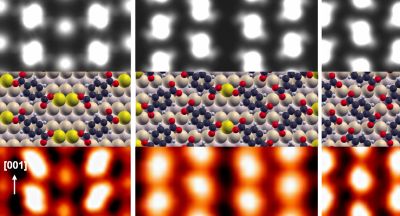News Library
Doubling the resolution, up to 32M, in Mass Spec
The O’Connor group has developed a computation which simultaneously doubles the resolution, sensitivity and mass accuracy of Fourier Transform Mass Spectrometry at no extra cost.
Probing dispersions of graphene-like molecules
Costantini and collaborators report in JACS on dispersions of HBC, an analogue to small graphene flakes.
When is a nanoparticle toxic?
The Gibson Group in collaboration with Pathologists from the Johannes Guttenburg University (Mainz) have published two studies onto the role of nanoparticle size and coating on their interactions with cells. The aim is to address questions regarding nanoparticle toxicity (if any). Focus was placed on cells from the vasculature (circulation). These cells are often negleted but any injected drug delivery system will encounter several kilometers of these. Several particle formations were found to enter endothelial cells associated with the blood-brain barrier - perhaps the most challenging biological barrier to drug delivery.
This work is published in Biomacromolecules: Read here and Particle Fibre Toxicology: Read here
and Particle Fibre Toxicology: Read here
(Particle Fibre Tox is No 1 Tox. Journal in ISI Citation reports, publishing Primary Research)
Irène Joliot-Curie Conference - Establishing an Independent Career in Chemistry
Establishing an independent academic career is an exciting and challenging process. The data available for UK chemistry suggests that more women than men find the process not exciting enough or too challenging. A key aspect of success in any career path is finding role models, establishing networks, and being tapped into good sources of information. Our aim is therefore to create opportunities for all of these in the first (and subsequent) Irène Joliot-Curie conference.
Unique pathway for pyrrole biosynthesis discovered
Prof. Greg Challis and Dr Lijiang Song, in collaboration with researchers at the University of Paris, report in Angewandte Chemie a hitherto unanticipated pathway for the biosynthesis of pyrroles from sugars. Using a combination of genetic engineering, isolation, structure elucidation, synthesis and feeding of biosynthetic intermediates, and incorporation of stable isotope-labelled precursors, the researchers showed that a carbohydrate, most likely N-acetylglucosamine-1-phosphate, is elaborated to the 4-acetamidopyrrole-2-carboxylate building blocks of the DNA-binding antibiotic congocidine (also known as netropsin). The assembly of pyrroles from carbohydrates is unprecedented in Nature and raises several intriguing questions regarding the mechanisms of the reactions involved. See http://onlinelibrary.wiley.com/doi/10.1002/anie.201201445/abstract for further details.
Nanodiamonds bring back sparkle to cleaning
Nanodiamonds have been found to help loosen crystallized fat from surfaces in a project led by Dr Andrew Marsh at University of Warwick. The tiny carbon particles transform the ability of surfactants to shift dirt in cold water, findings that could bring eco friendly low temperature laundry cycles.
The research is published in ACS Applied Materials and Interfaces and highlighted in the Daily Mail and Daily Telegraph, 26 June.
Nanodiamond Promotes Surfactant-Mediated Triglyceride Removal from a Hydrophobic Surface at or below Room Temperature Xianjin Cui, Xianping Liu, Andrew S. Tatton, Steven P. Brown, Haitao Ye, and Andrew Marsh ACS Applied Materials and Interfaces 2012, http://dx.doi.org/10.1021/am300560z
Challis group discover unprecedented alkaloid
The Challis group and collaborators at the John Innes Centre report in the journal Chemical Science on the genomics-driven discovery of a novel polyketide alkaloid with an unprecedented structure. Incorporation experiments with stable isotope-labelled precursors combined with bioinformatics analyses were used to deduce the likely biosynthetic pathway for the natural product. See http://pubs.rsc.org/en/content/articlelanding/2012/sc/c2sc20410j for further details.
Macpherson and Unwin and co-workers featured in "Chemistry World" and Chemical Communications
Macpherson and Unwin and co-workers Challenge the Current Consensus on the Electrochemical Properties of Nanotubes as featured in "Chemistry World" http://www.rsc.org/chemistryworld/2012/06/challenging-consensus-nanotube-electrochemistry and Chemical Communications http://pubs.rsc.org/en/content/articlelanding/2012/cc/c2cc32890a
and Chemical Communications http://pubs.rsc.org/en/content/articlelanding/2012/cc/c2cc32890a .
.
Unwin and O'Reilly win prestigious RSC awards
Pat Unwin and Rachel O’Reilly win 2012 Royal Society of Chemistry Awards in recognition of significant contributions to their research fields
Inverted membranes by ion soft landing
Costantini and co-workers report in Advanced Materials on the fabrication of inverted crystalline membranes of sodium dodecyl sulfate by ESI deposition.
Structural studies on a Meningitis B vaccine
Results by MOAC and chemistry PhD student Angela Martino and her supervisor Alison Rodger were published this week on 4CMenB (a new meningococcal B vaccine).
At surfaces it's different
Costantini and collaborators have reported in a special themed issue of Chemical Communications about a novel chemical pathway observed only in the presence of a metal substrate. In solution chemistry, assuming no kinetic limitations, the thermodynamic product is formed independently of the absolute reactant concentration. However, inclusion of a metallic substrate introduces a further variable which ultimately defines the chemistry observed. In their recent work, terephthalic acid was deposited onto a Cu(110) substrate, where, at low surface coverages, 2-dimensional metal-organic structures form. However, with increasing coverage, the interaction between molecule and metal induces the formation of a denser, less energetically-favoured hydrogen-bonded network.
The article can be read here .
.

